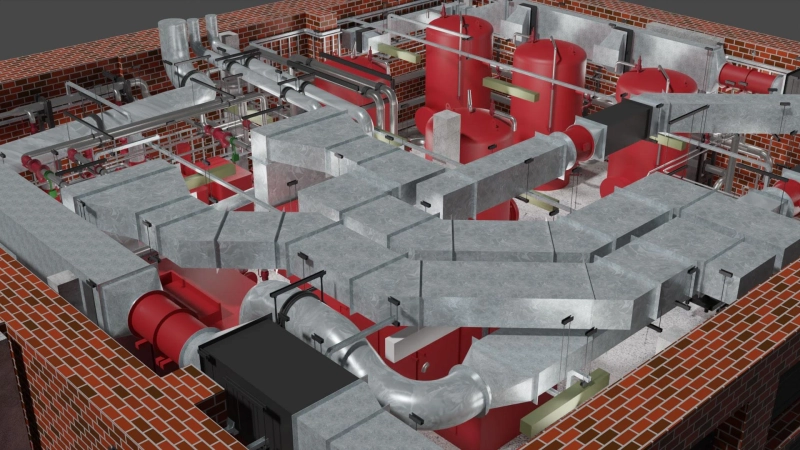In the realm of construction and architecture, the integration of Mechanical, Electrical, and Plumbing (MEP) services stands as a pivotal point where design aspirations meet practical functionality. This integration is where the vision of a building takes shape, ensuring that aesthetic appeal harmonizes seamlessly with the operational efficiency and comfort of its occupants. In this discourse, we delve into the intricacies of MEP services, exploring how they intersect with design principles to create spaces that are not only visually striking but also functionally efficient.
Understanding MEP Services
Before delving into the integration of MEP services with design, it's crucial to comprehend the breadth of these services. MEP encompasses a wide array of systems crucial for any building's functionality, including heating, ventilation, air conditioning (HVAC), electrical distribution, lighting, plumbing, fire protection, and more. Each of these systems plays a vital role in ensuring the comfort, safety, and sustainability of a structure.
Harmonizing Aesthetics and Functionality
In the past, MEP systems were often considered as functional necessities, relegated to hidden spaces within a building. However, contemporary architectural trends have shifted towards a more integrated approach, where MEP systems are not only functional but also contribute to the overall design aesthetic.
Spatial Considerations
Architects and MEP engineers collaborate closely to integrate systems seamlessly into the architectural design. This involves strategic planning to allocate space for MEP equipment, ductwork, piping, and conduits without compromising the design integrity or spatial experience of the building's occupants.
Aesthetic Integration
MEP components are no longer concealed but rather celebrated as design elements. For instance, exposed ductwork and piping can add an industrial or contemporary flair to interiors, while carefully curated lighting fixtures become focal points that enhance the ambiance of a space.
Material Selection
From sustainable HVAC systems to energy-efficient lighting fixtures, the choice of MEP materials and technologies can significantly impact both the environmental footprint and the aesthetic appeal of a building. Integrating eco-friendly MEP solutions not only aligns with sustainability goals but also enhances the overall design narrative.
Designing for Efficiency and Comfort
While aesthetics are undoubtedly crucial, the primary function of MEP services is to ensure the comfort, safety, and well-being of building occupants. Integrating MEP systems into the design process enables architects to create spaces that prioritize both efficiency and comfort.
HVAC Design
Proper HVAC design is essential for maintaining optimal indoor air quality and temperature control. By integrating HVAC systems early in the design phase, architects can optimize the placement of vents, ducts, and equipment to ensure efficient airflow while minimizing energy consumption.
Daylighting and Lighting Design
Natural light plays a significant role in occupant comfort and well-being. Integrating daylighting strategies into the design, such as strategically placed windows, skylights, and light shelves, can reduce the need for artificial lighting while enhancing the visual appeal of interior spaces. Furthermore, thoughtful lighting design not only illuminates a space but also sets the mood and enhances architectural features.
Plumbing and Water Management
Efficient plumbing design is crucial for conserving water and minimizing the risk of leaks or water damage. By integrating water-efficient fixtures, greywater recycling systems, and sustainable drainage solutions into the design, architects can contribute to both environmental sustainability and operational efficiency.
Challenges and Solutions
Despite the benefits of integrating MEP services with design, several challenges may arise, ranging from space constraints to budgetary considerations. However, proactive collaboration between architects, engineers, and contractors can help overcome these challenges and optimize the integration of MEP systems.
Early Collaboration
Engaging MEP engineers and contractors early in the design process allows for better coordination and integration of systems. By fostering interdisciplinary collaboration, architects can address potential conflicts or design constraints before they become significant issues, resulting in smoother project execution.
Technology Integration
The rapid advancement of Building Information Modeling (BIM) technology has revolutionized the way MEP systems are designed, visualized, and coordinated. BIM enables architects and engineers to create digital models that simulate the performance of MEP systems, allowing for more accurate planning and analysis.
Sustainability Integration
With increasing emphasis on sustainability and energy efficiency, integrating MEP services with green building principles has become paramount. By incorporating renewable energy sources, energy-efficient technologies, and sustainable materials into the design, architects can create buildings that not only minimize environmental impact but also reduce operational costs over time.
Case Studies
To illustrate the successful integration of MEP services with design principles, let's explore two exemplary case studies:
The Edge, Amsterdam:
Designed by PLP Architecture and installed with cutting-edge MEP systems by Arup, The Edge is widely regarded as one of the world's most sustainable office buildings. Its innovative design features include triple-glazed facades for energy efficiency, a smart lighting system that adjusts based on occupancy and daylight levels, and an aquifer thermal energy storage system for heating and cooling.
One Central Park, Sydney
Designed by Ateliers Jean Nouvel and installed with MEP systems by Arup, One Central Park exemplifies the integration of sustainability and aesthetics. Its iconic cantilevered heliostat reflects sunlight into the building's interior gardens, reducing the need for artificial lighting. Additionally, the building features a tri-generation plant that generates electricity, heating, and cooling using natural gas and solar power.
Conclusion
The integration of MEP services with architectural design represents a convergence of functionality, efficiency, and aesthetics. ENGISOFT ENGINEERING - BIM Staffing & BIM Services By prioritizing collaboration, sustainability, and innovation, architects can create spaces that not only captivate the senses but also enhance the well-being and productivity of their occupants. As we continue to push the boundaries of design and technology, the intersection of MEP services will remain a cornerstone of architectural excellence in the built environment.


